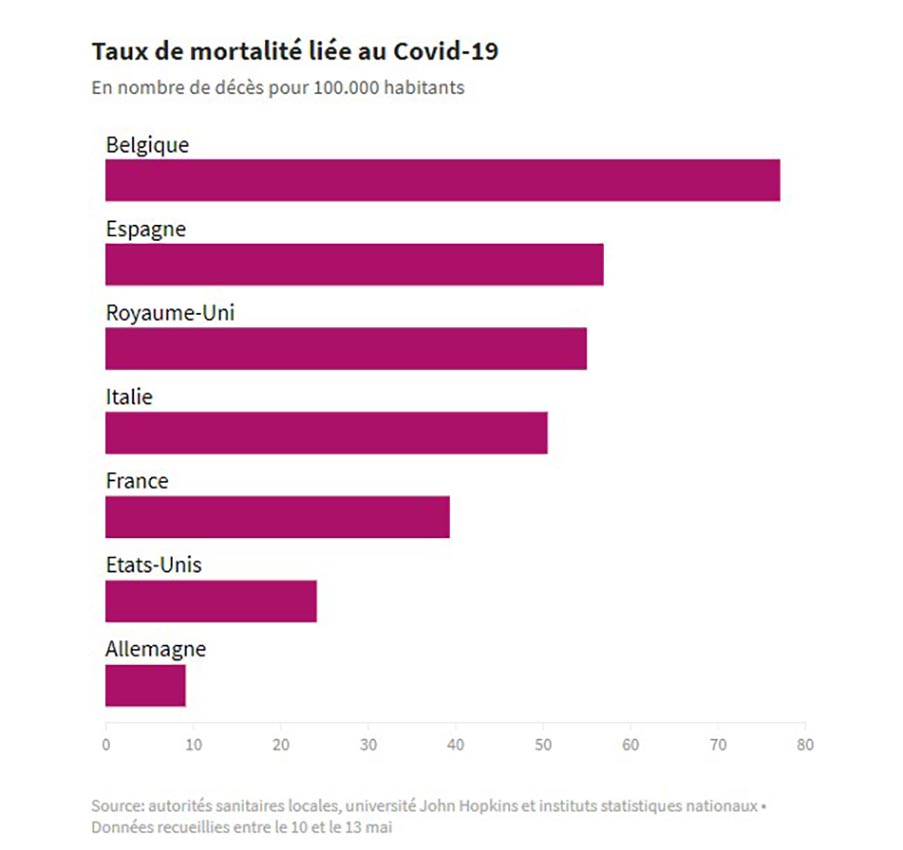Putting COVID-19 In Perspective
COVID-19 is understandingly scaring many people.
There has been an ongoing battle of figures – real or estimated or, worse, simulated – which have been part of the pandemic.
But several comparative studies have shown a more reassuring picture by putting what we know so far into prospective on at least three grounds.
First, it is early to know but, at this stage of the pandemic, Covid-19 is much less deadly than some other illnesses decimating people on a regular basis (AIDS in Africa is one example).
Second, Europe and the United States are considered the most hit by the pandemic, but compared to what ?
The question here is not only reliable data, but existing data.
The statistics provided by some major countries such as China and Russia are to say the least surprising.
To try to have an accurate picture, one can only try to calculate the ratio between Covid-19 deaths as a percentage of the overall population.
In the U.S. case, as of May 16, 2020, there are 89,135 deaths out a total population of 331,002,651 inhabitants.
This means that the percentage of deaths from COVID-19 represents a percentage of 0.026 % of the overall U.S, population.
Maybe not the perfect way to do things, but much more reassuring than the percentage of deaths out of Covid cases’account that is generally shown, knowing that the latter depends on the testing being done, and accurately done, and the calculation of fatalities.
A recent article published in the French economic newspaper Les Echos tends to dismiss such ratio as invalid because it “erases the virulence of some outbreaks“, such as in New York. Still, besides luck or lack of it, it does provide interesting data about countries overall and helps correct some misconception as far as crisis management at a national level is concerned.

Mortality rate per 100.000 inhabitants in Western democracies:
the United States stands between France and Germany
And even this number of 89, 135 could be inaccurate, as countries have been in some cases going back and forth in counting elderly people.
Indeed the Governor of Colorado recently corrected the record as reported by CDC with data from the Colorado health care system, by pointing out that one should differentiate between those who dies with Coronavirus from those who died from Coronavirus.
“Colorado Gov. Jared Polis said state health officials should always rely on data from a coroner, rather than their own analysis of death certificates, when it comes to reporting data on COVID-19 deaths.”
A third issue to be considered is the waiting for technology case.
We have been hearing about the need for a tracing app to complement traditional means of epidemiological investigation; one which would work as the magic silver bullet to help contain the pandemic.
Many countries are indeed working on one and/or implementing it in their population with various levels of freedom.
A recent “lessons learned” on the usefulness of such a tool comes from Iceland, one of the very first countries to have done so and a success story so far in handling the pandemic.
According to a recent MIT Technology Review article:
‘’Within a few weeks, Icelanders had another high-tech tool at their disposal, too: a government-backed automated tracing app.
Rakning C-19, which launched in early April, was hailed as a way to “make the tracing of transmissions easier” at the time. It tracks users’ GPS data to compile a record of where they have been, allowing investigators—with permission—to look at whether those with a positive diagnosis are potentially spreading the disease.
And it gained traction quickly: according to MIT Technology Review’s Covid Tracing Tracker, it has the largest penetration rate of all contact trackers in the world, having been downloaded by 38% of Iceland’s population of 364,000.
But despite this early deployment and widespread use, one senior figure in the country’s covid-19 response says the real impact of Rakning C-19 has been small, compared with manual tracing techniques like phone calls.
“The technology is more or less … I wouldn’t say useless,” says Gestur Pálmason, a detective inspector with the Icelandic Police Service who is overseeing contact tracing efforts. “But it’s the integration of the two that gives you results. I would say it [Rakning] has proven useful in a few cases, but it wasn’t a game changer for us.”
In short, putting the crisis in perspective could help to move forward…
